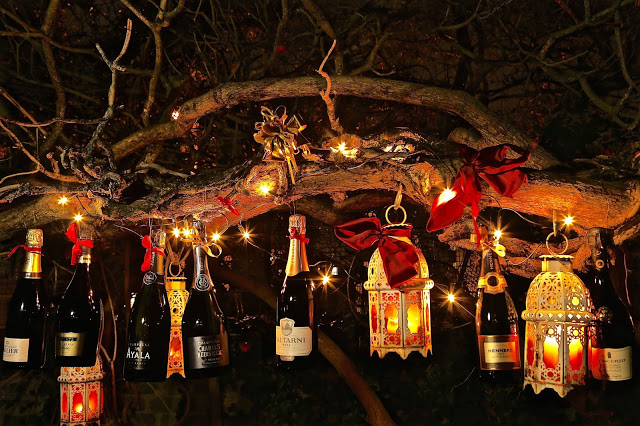
Christmas and New Year’s Eve is when we pop open the corks on sparkling wines and Champagnes, a time to heap unstinting rewards upon ourselves for having got through yet another year. Is there any moment when opening a bottle of fizz is wrong during the holidays?
Let me think, er… *strokes chin*… NO!
Here are my Christmas champers tips:
- There are choices below from just under a tenner to a top of the range £65. If you have guests round, start off with the expensive bottle and then switch down to the cheaper stuff as you get progressively drunker.
- You can drink Champagne with every single meal or as a standalone drink. It’s great for breakfast, lunch, dinner, tea, aperitifs and dessert. It’s great in the bath, in front of the fireplace, in the kitchen, around the dining table, around the Christmas tree, in bed, before sex, during sex and after sex. Anywhere and anytime in fact.
- Diet and nutrition: Champagne should form part of any healthy well balanced diet. Ok, I just made that up but… I do believe that Champagne is an anti-depressant. Once, when attending the film festival I went on what I call ‘The Cannes Diet’, which consisted of a solid week of Champagne and canapés. I lost a ton of weight.
- Champagne is low carb and gluten free!
- Cocktails: With the slighter cheaper varieties feel free to make champagne cocktails diluted with a little orange juice (Bucks Fizz) or peach juice (Bellini), grapefruit juice, with Creme de Cassis (Kir Royale). I personally carry around a handbag-sized mini Creme de Cassis so I’m never in a situation where a sparkling wine is a little too dry. I can instantly tart up even the dodgiest of champers. Phew.
- Champagne Punch is a wonderful way to drink Champagne if you are having a party. Punch comes from the Indian ‘panch’ meaning five, so Punch usually has at least five ingredients. There is a fantastic Regency Champagne Punch recipe in my book MsMarmitelover’s Secret Tea Party as well as other ‘teapot’ cocktails.
- Cooking: experts say you should only cook with a wine that you would drink but this interesting article says that leftover oxidised Champagne in a bottle can easily be used in cooking; the heat will disguise any off-flavours.
- Food Matching: one of my favourite matches for champagne is Marmite. Yes Marmite soldiers dipped into melted Langres cheese – yum. Lovely as a starter or cheese course. Or even simply with Marmite on toast.
- Glasses: use Champagne flutes rather than breast-like coupe glasses, the bubbles won’t disappear so quickly.
- How to open Champagne: remove the ‘cage’ if the bottle has one, then gradually turn the cork around in the neck, holding the bottle with one hand and the cork with the other, it should start to relieve pressure, then ease out the cork. Feel free to hold it over a sink.
- Putting a spoon in the top of an opened bottle, is it a myth? I’m afraid so, according to the Scientific American, the teaspoon has no magical bubble preserving qualities.
- If you like the bubbles, keep the Champagne very cold and pour the stream into the glass by hitting the side of the glass not the bottom.
- A good Champagne or sparkling wine will not lose its fizz quickly. It should last at least a couple of days, even up to a week, in the fridge.
- However it’s best to use a special Champagne stopper. Invest in one now.
- Art: make wire sculptures with the cage!
- Rather like the German wine system, Champagne comes in different levels of sweetness:
- Extra Brut: very dry
- Brut: very dry to dry
- Extra-Sec or Extra-Dry: off-dry to medium dry
- Sec: medium dry
- Demi-Sec: sweet
- Doux: super-sweet
- The British tend to only drink Brut Champagne but sometimes a sweeter Champagne is just right. Historically, sweeter champagne was more popular in France and drier styles were produced to please us Brits. However recently a sweeter softer more ‘casual’ Champagne has been introduced to appeal to younger drinkers.
- The British are the biggest consumers of Champagne in the world after the French.
- British sparkling wine is now damn good. Sussex has a similar terrain, sandy and chalky, to the Champagne region; the land continues from North East France to under the channel, surfacing in Sussex. Except you have in addition the gorgeous minerality of the sea air. Sussex produces very high quality wines. If you haven’t tried British ‘Champagne’, make sure you do this Christmas.
Left to right (on picture, above):
Lallier Grand Cru Grande Reservé £24 classic French Champagne.
Vallate Extra Dry Prosecco £9.99 Fantastic aperitif and cheap enough to make into a Champagne cocktail.
Ayala Brut Majeur £25 Choose this to go with a traditional smoked salmon and scrambled egg breakfast on Christmas mornings. “Brioche with sugar crystals on top” Victoria Moore.
Charles Heidsieck £65 in a gift set with two special edition glasses. Fantastic with food.
Taltarni Tachz Rosz £17 good with Asian dishes. After the heaviness of the Christmas Day feasting, I like something lighter on Boxing Day, perhaps Asian or Indian food. This would be perfect.
Henners Brut Reserve £18 (Vegan and Vegetarian) A British sparkling wine from Sussex. Fab canapé accompaniment.
Lambrusco Rosso Reggiano Concerto £11.95 Chuck away your prejudices against Lambrusco and try this sparkling red. People rarely enjoy fizzy red in the UK but it’s very popular in Italy and goes beautifully with certain foods. This is one you can serve with any Italian food such as pasta and I love it with chocolate too.
